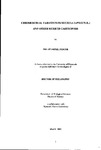CHROMOSOMAL VARIATION IN NUCELLA LAPILLUS (L.) AND OTHER MURICID GASTROPODS
| dc.contributor.author | PASCOE, PHILIP LIONEL | |
| dc.contributor.other | Faculty of Science and Engineering | en_US |
| dc.date.accessioned | 2013-11-07T11:17:40Z | |
| dc.date.available | 2013-11-07T11:17:40Z | |
| dc.date.issued | 2002 | |
| dc.identifier | NOT AVAILABLE | en_US |
| dc.identifier.uri | http://hdl.handle.net/10026.1/2654 | |
| dc.description.abstract |
The Robertsonian polymorphism (numerical change in the chromosome complement by centric fusion or fission) in the dog-whelk (Nucella lapillus, Mollusca: Gastropoda) has been known and studied sporadically for almost 50 years. However, the possible causes, consequences and proposed correlations of this phenomenon remain enigmatic. Nucella lapillus (2n = 26 to 36), has undergone a marked reduction in chromosome number from its ancestral form; most other muricid species have a diploid chromosome number in the range 2n = 60- 70. Correlations have been proposed between chromosome number (or karyotype) and habitat (wave exposure), and also directly or indirectly with allozymes, shell shape and physiology. However, firm conclusions are lacking due to either, insufficient knowledge of the karyotypes in the populations studied, or the fact that any correlations are not consistent throughout the broad geographic range. This study reviews all the past research on the chromosomal polymorphism in N. lapillus, advances the karyology of this species by successfully labelling individual chromosomes through silver-staining of nucleolar organizer regions (NORs) and fluorescence in situ hybridisation (FISH) with rDNA and telomeric probes, and proposes a new system of nomenclature for this polymorphism. Knowledge of the geographic variation in chromosome number and karyotype is advanced by studying around 70 populations throughout the range of N. lapillus (mainly in the UK, but also the USA and northern and southern Europe). Evidence is shown that, (1) the polymorphism is far more widespread geographically than was previously thought; (2) more than five pairs of metacentric chromosomes are involved in the Robertsonian polymorphism; and (3) inversions also occur in some populations. Putative links between chromosomal polymorphism in N. lapillus and Darwinian fitness are reviewed in the light of the new findings and more recent work on other species; data are presented on fecundity, fertility, inter- and intra-individual variation in karyotype, selection within populations (adults v. embryos, homo- v. heterozygotes) and a possible genetic/karyotypic link with phenotype (Dumpton syndrome, a reproductive abnormality). Cytogenetic records for other muricids are also reviewed and karyotypes and chromosome lengths of four other species (Ocenebra erinacea, Thais haemastoma, Murex trunculus, Ocinebrina aciculata) are recorded for the first time. Genome size (DNA content) of 8 species of muricid, including the 2n=26 and 2n=36 forms of N. lapillus, are determined by Feulgen densitometry and compared in the context of evolutionary studies on the family. Although chromosome number and haploid length in N. lapillus has been reduced, its genome size is actually greater than all but one of the other muricids studied, and consequently has a much higher DNA packing ratio (>13000). Whether the chromosomal variation in N. lapillus represents polymorphism, polytypy, or speciation in progress remains unresolved, but substantial advances have been made in this dissertation and the required direction and focus for future work are clarified. | en_US |
| dc.description.sponsorship | Plymouth Marine Laboratory | en_US |
| dc.language.iso | en | en_US |
| dc.publisher | University of Plymouth | en_US |
| dc.title | CHROMOSOMAL VARIATION IN NUCELLA LAPILLUS (L.) AND OTHER MURICID GASTROPODS | en_US |
| dc.type | Thesis | |
| plymouth.version | Full version | en_US |
| dc.identifier.doi | http://dx.doi.org/10.24382/4238 |
Files in this item
This item appears in the following Collection(s)
-
01 Research Theses Main Collection
Research Theses Main


